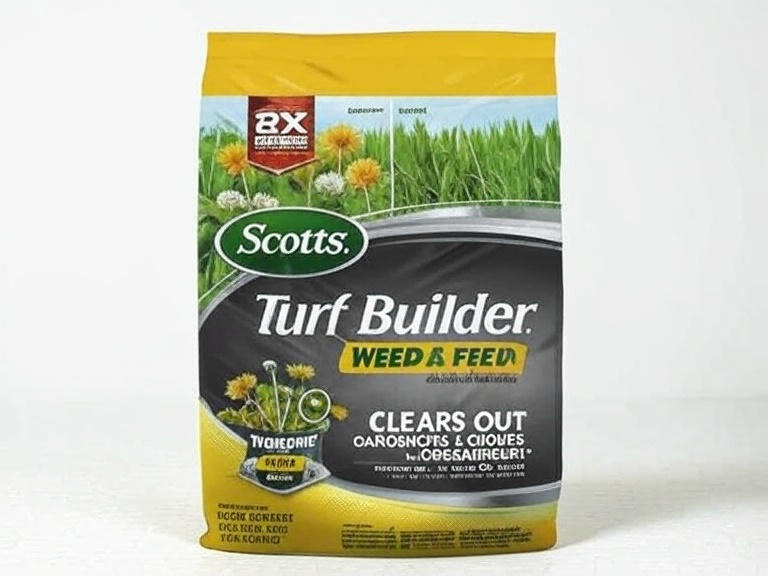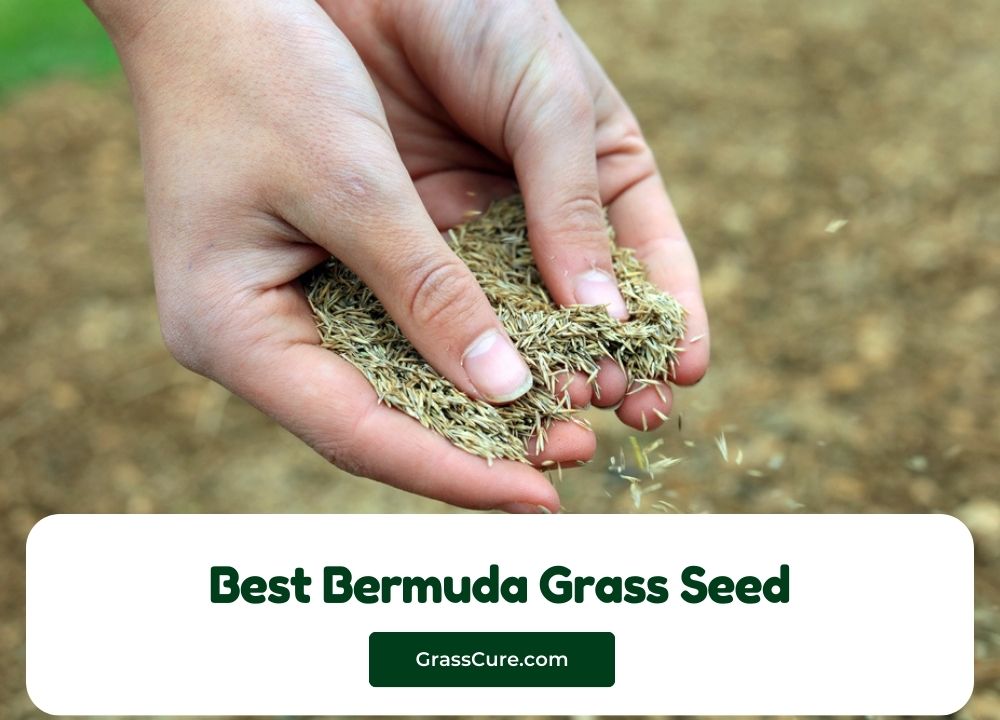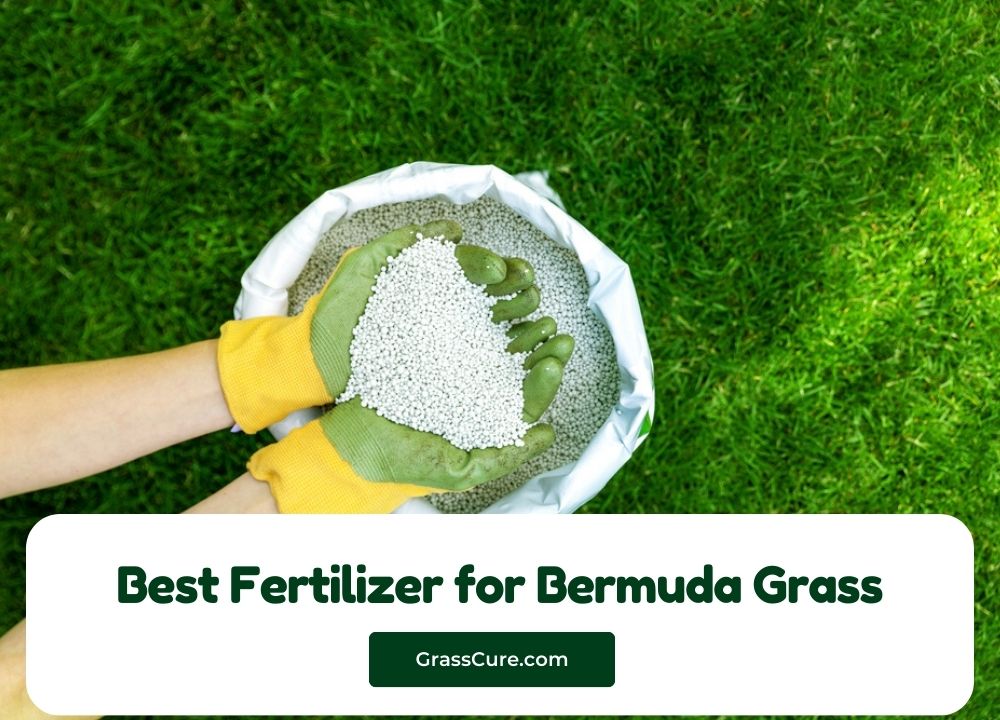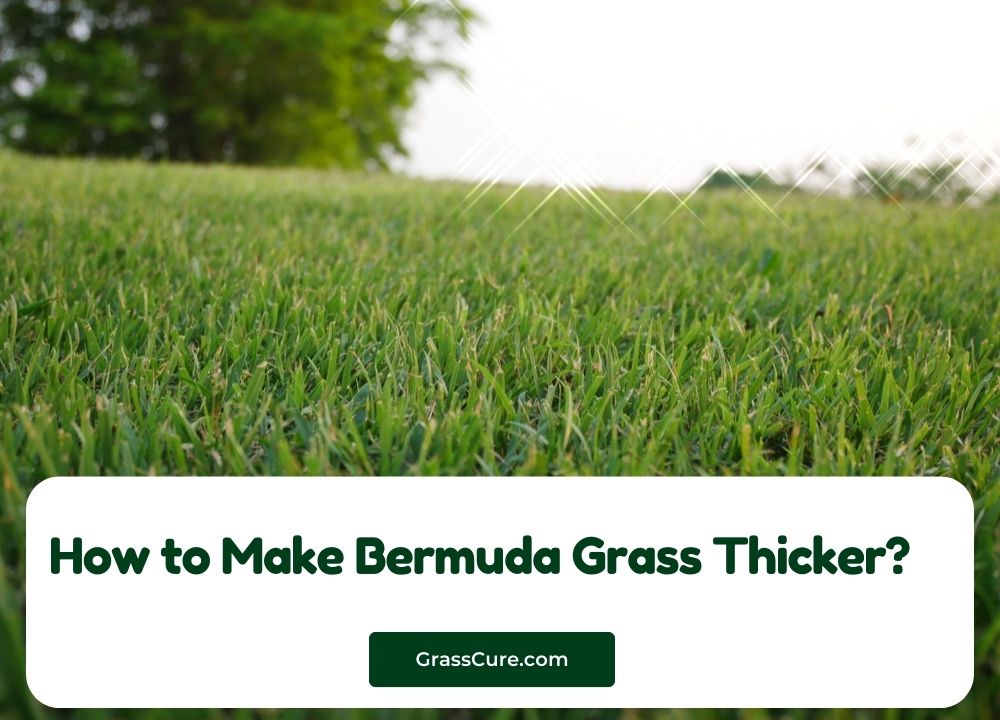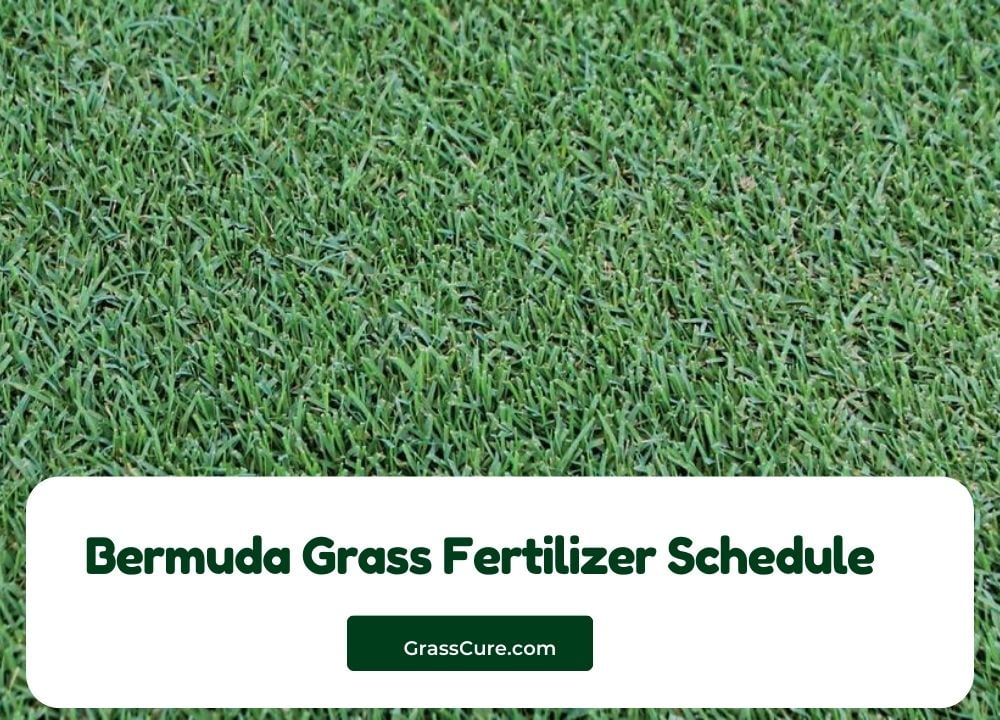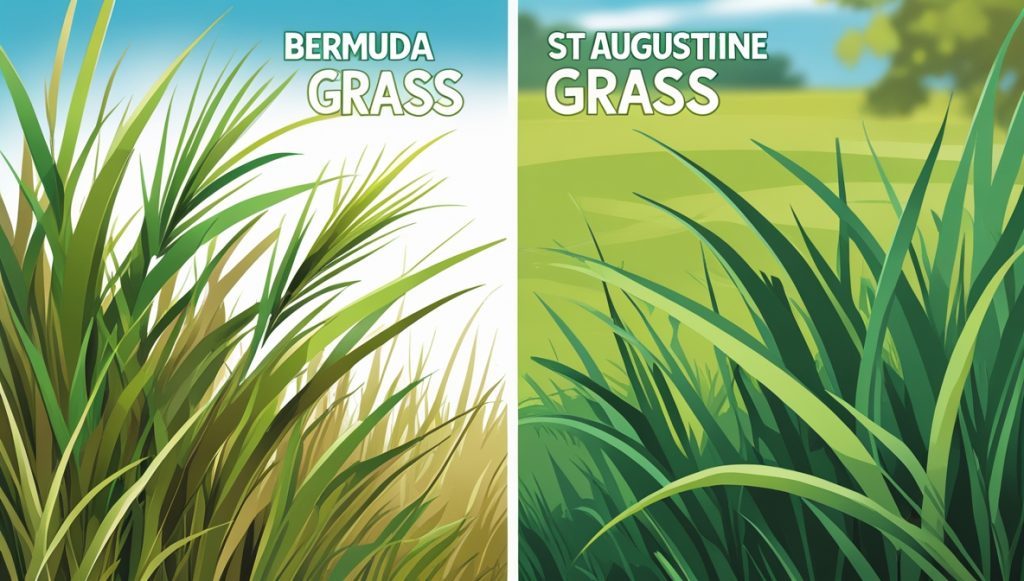Bermuda grass lawns thrive in warm climates, delivering lush, green carpets that elevate curb appeal. However, weeds like dandelions, clover, and crabgrass can invade, stealing nutrients and ruining the look. A quality weed and feed product tackles these pests while nourishing your lawn. After extensive research, testing, and user feedback analysis, I’ve compiled the top five weed and feed products for Bermuda grass in 2025. This guide breaks down each product, its strengths, weaknesses, and why it suits Bermuda grass, helping you choose the best option for a weed-free, vibrant lawn.
Contents
- Why Choose a Weed and Feed for Bermuda Grass?
- How We Selected the Top Products
- 1. Scotts Turf Builder Weed & Feed3 – Best Overall
- 2. Spectracide Weed & Feed 20-0-0 – Best Liquid Option
- 3. BioAdvanced 5 In 1 Weed and Feed – Best for Long-Term Weed Prevention
- 4. Scotts Turf Builder Triple ActionI – Best for Crabgrass Prevention
- 5. Pennington Full Season W&F+Crab 4M – Best Budget Granular
- Comparison Table: Top 5 Weed and Feed Products for Bermuda Grass
- How to Choose the Right Weed and Feed for Your Bermuda Grass
- Tips for Applying Weed and Feed on Bermuda Grass
- Common Weeds in Bermuda Grass Lawns and How to Tackle Them
- Environmental and Safety Considerations
- Frequently Asked Questions
- Conclusion: Which Weed and Feed Is Right for Your Bermuda Grass?
Why Choose a Weed and Feed for Bermuda Grass?
Bermuda grass, a warm-season turf, loves heat and withstands drought, making it popular in southern states like Texas, Florida, and Georgia. Its aggressive growth demands specific care, especially when battling weeds. Weed and feed products combine herbicides to kill or prevent weeds with fertilizers to boost grass health. For Bermuda grass, the right product must target broadleaf and grassy weeds without harming the turf, while delivering nutrients like nitrogen for vigorous growth.
Choosing the best weed and feed involves understanding your lawn’s needs, local climate, and weed types. Bermuda grass tolerates many herbicides, but some products, like those designed for St. Augustine grass, can damage it. This guide focuses on Bermuda-safe options, ensuring you get effective weed control and robust fertilization.
How We Selected the Top Products
To find the best weed and feed for Bermuda grass, I evaluated products based on:
- Effectiveness: How well they kill weeds like dandelions, clover, and crabgrass while promoting Bermuda grass growth.
- Safety: Compatibility with Bermuda grass to avoid lawn burn or damage.
- Ease of Application: User-friendly formats, whether granular or liquid.
- Coverage: Square footage treated per package for cost efficiency.
- Nutrient Profile: Fertilizer ratios (NPK) suited for Bermuda grass.
- User Feedback: Real-world experiences from homeowners and lawn care enthusiasts.
- Value: Price versus performance and coverage.
I also considered 2025 lawn care trends, environmental concerns, and Bermuda grass’s unique needs in warm climates. The five products below stood out for their performance, reliability, and suitability.
1. Scotts Turf Builder Weed & Feed3 – Best Overall
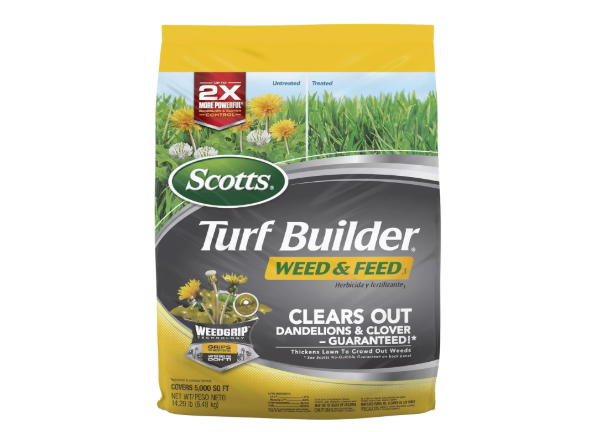
Coverage: 5,000 sq. ft.
NPK Ratio: 28-0-3
Active Ingredients: 2,4-D, Dicamba
Application: Granular, requires spreader
Scotts Turf Builder Weed & Feed3 earns the top spot for its powerful weed control and Bermuda grass nourishment. Designed for warm-season grasses like Bermuda, it targets over 50 broadleaf weeds, including dandelions, clover, and plantain, while feeding the lawn to crowd out future invaders. Its WeedGrip Technology ensures herbicides cling to weed leaves, delivering fast results.
Why It’s Great for Bermuda Grass
Bermuda grass thrives with high nitrogen, and this product’s 28-0-3 formula fuels rapid growth and greening. Users report noticeable weed die-off within two weeks, with dandelions yellowing in days. The fertilizer thickens Bermuda’s dense growth, helping it outcompete weeds naturally. Safe for Bermuda, bahiagrass, and zoysiagrass, it’s versatile for southern lawns.
How to Apply
Apply to a wet lawn when weeds are actively growing, ideally in spring or early fall when temperatures range between 60°F and 90°F. Use a Scotts broadcast spreader set to 3 ¾ or a drop spreader at 7 ¼. Avoid watering for 24 hours post-application to let the herbicide work. One 14.29-pound bag covers 5,000 square feet, perfect for medium-sized lawns.
Pros
- Kills over 50 weed types, including tough dandelions and clover.
- High nitrogen (28%) promotes lush Bermuda growth.
- Easy-to-use granular formula with clear spreader settings.
- Thickens lawn to prevent future weeds.
- Positive user reviews praise greening and weed control.
Cons
- Requires a spreader, adding cost if you don’t own one.
- Not safe for St. Augustine or new grass (must mow 4 times first).
- Some users note inconsistent weed kill in heavy infestations.
User Feedback
Homeowners love the greening effect, with one Texas user saying, “My Bermuda lawn went from patchy to lush in weeks, and dandelions vanished!” Another praised its ease, noting, “Applied with morning dew, and clover was gone in 10 days.” Some reported needing a second application for stubborn weeds, but overall, it’s a crowd-pleaser.
Why Choose It?
Scotts Turf Builder Weed & Feed3 balances affordability, coverage, and performance. Its high nitrogen content and broad weed control make it ideal for Bermuda grass owners seeking a vibrant, weed-free lawn without breaking the bank.
2. Spectracide Weed & Feed 20-0-0 – Best Liquid Option
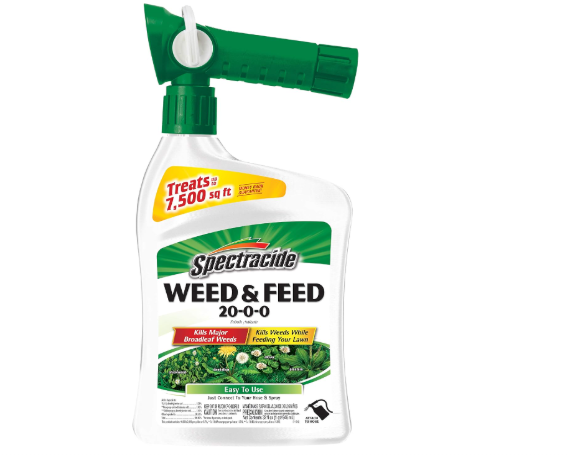
Coverage: 7,500 sq. ft.
NPK Ratio: 20-0-0
Active Ingredients: 2,4-D, Mecoprop-p, Dicamba
Application: Ready-to-spray liquid, hose-end sprayer
Spectracide Weed & Feed 20-0-0 offers a convenient liquid solution for Bermuda grass lawns. Its ready-to-spray bottle connects to a garden hose, making application a breeze for homeowners without spreaders. It targets broadleaf weeds like dandelions, clover, and poison ivy while feeding grass with nitrogen.
Why It’s Great for Bermuda Grass
Bermuda grass responds well to liquid fertilizers, absorbing nutrients quickly through blades and roots. Spectracide’s 20% nitrogen formula greens lawns fast, with users seeing results in days. Safe for Bermuda, fescue, and ryegrass, it’s a versatile choice. The liquid format ensures even coverage, reducing the risk of lawn burn when applied correctly.
How to Apply
Shake the 32-ounce bottle, connect it to a hose, and flip the QuickFlip switch to spray. Apply to a dry lawn, walking slowly to cover evenly. Water the lawn 1-2 days before, then avoid watering for 24 hours after. One bottle treats up to 7,500 square feet, offering excellent value for larger lawns.
Pros
- No spreader needed; hose-end sprayer simplifies application.
- Affordable at ~$13 for 7,500 sq. ft. coverage.
- Kills broadleaf weeds, including poison ivy and clover.
- Fast-acting nitrogen greens Bermuda grass quickly.
- Ideal for homeowners seeking convenience.
Cons
- Less effective on grassy weeds like crabgrass.
- Strong chemical smell lingers for days.
- Requires careful application to avoid overspray on non-target plants.
User Feedback
Users rave about the ease of use, with one saying, “I sprayed it on my Bermuda lawn, and dandelions were toast in a week!” Another noted, “My grass greened up fast, but the smell was intense.” Some wished it tackled crabgrass better, but for broadleaf weeds, it’s a winner.
Why Choose It?
Spectracide is perfect for those who want a budget-friendly, no-fuss liquid weed and feed. Its large coverage and quick results make it a go-to for Bermuda grass owners prioritizing convenience.
3. BioAdvanced 5 In 1 Weed and Feed – Best for Long-Term Weed Prevention
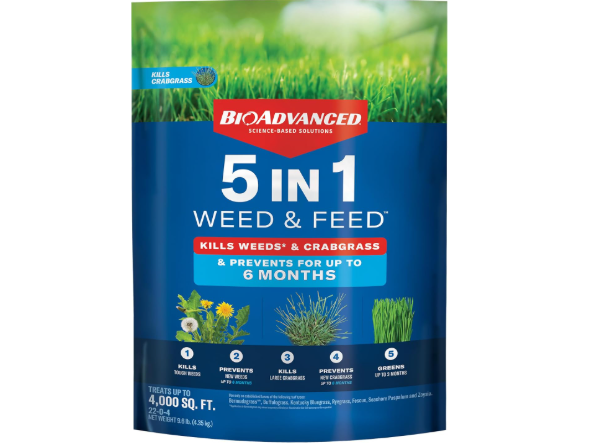
Coverage: 10,000 sq. ft.
NPK Ratio: 22-0-4
Active Ingredients: 2,4-D, Quinclorac, Dicamba, Dithiopyr
Application: Granular, requires spreader
BioAdvanced 5 In 1 Weed and Feed stands out for its comprehensive approach, tackling both existing weeds and preventing new ones for up to six months. It’s a granular product safe for Bermuda grass, targeting over 200 broadleaf and grassy weeds, including crabgrass, while feeding the lawn.
Why It’s Great for Bermuda Grass
This product’s pre- and post-emergent herbicides offer dual-action weed control, ideal for Bermuda lawns plagued by crabgrass or dandelions. The 22-0-4 formula provides balanced nitrogen and potassium, boosting Bermuda’s heat and drought resistance. Users report thicker, greener lawns that require less frequent mowing.
How to Apply
Apply 2.4 pounds per 1,000 square feet using a rotary or drop spreader when temperatures are 50-90°F. Ensure the lawn is dry, and water thoroughly after application. The 9.6-pound bag covers 10,000 square feet, making it cost-effective for large lawns. Avoid using on St. Augustine or new grass.
Pros
- Prevents weeds for up to six months, including crabgrass.
- Kills over 200 weed types, from clover to goosegrass.
- Enhances Bermuda’s drought and heat tolerance.
- Large coverage (10,000 sq. ft.) for the price.
- Slow-release formula feeds for three months.
Cons
- Requires precise spreader settings to avoid lawn burn.
- Not safe for all grass types, like St. Augustine.
- Granules take longer to show results than liquids.
User Feedback
Lawn enthusiasts praise its long-lasting weed prevention, with one user noting, “Crabgrass vanished, and my Bermuda lawn stayed green all summer!” Another said, “It took a week to see weed die-off, but the results lasted months.” Some reported uneven spreading causing patchy results, emphasizing the need for careful application.
Why Choose It?
BioAdvanced is the best pick for Bermuda grass owners battling persistent weeds and seeking long-term prevention. Its robust formula and large coverage make it worth the investment.
4. Scotts Turf Builder Triple ActionI – Best for Crabgrass Prevention
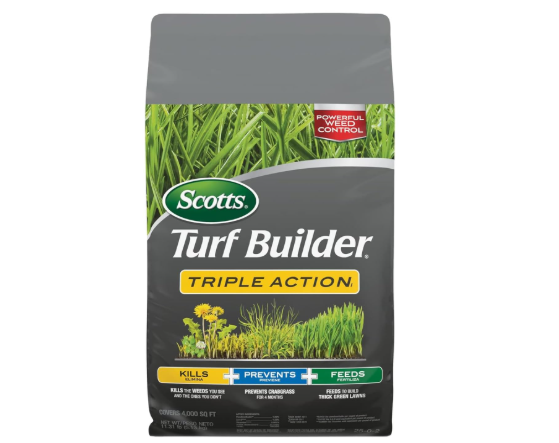
Coverage: 4,000 sq. ft.
NPK Ratio: 16-0-1
Active Ingredients: 2,4-D, Pendimethalin
Application: Granular, requires spreader
Scotts Turf Builder Triple ActionI combines weed killing, crabgrass prevention, and fertilization in one bag. Safe for Bermuda grass, it targets broadleaf weeds like dandelions and clover while preventing crabgrass for up to four months. Its lower nitrogen content suits lawns needing balanced care.
Why It’s Great for Bermuda Grass
Bermuda grass often faces crabgrass invasions, and this product’s pendimethalin stops grassy weeds before they sprout. The 16-0-1 formula supports steady growth without overstimulating, ideal for maintaining established Bermuda lawns. Users report fewer weeds and healthier turf after spring applications.
How to Apply
Apply to a wet lawn in early spring when dandelions are growing, using a Scotts spreader (broadcast at 3 ½, drop at 7 ¼). Water after 24 hours to activate crabgrass prevention. The 11.31-pound bag covers 4,000 square feet. Avoid use on St. Augustine or newly seeded lawns.
Pros
- Prevents crabgrass and other grassy weeds for four months.
- Kills broadleaf weeds like dandelions and clover.
- Balanced fertilizer supports Bermuda without excessive growth.
- Effective for warm-season lawns.
Cons
- Smaller coverage (4,000 sq. ft.) than competitors.
- Higher price point for less coverage.
- Doesn’t kill existing crabgrass, only prevents it.
User Feedback
Users appreciate the crabgrass control, with one saying, “My Bermuda lawn stayed weed-free all spring after using this.” Another noted, “It greened up my grass nicely, but I needed a separate product for existing crabgrass.” The smaller coverage disappointed some, but performance won them over.
Why Choose It?
Scotts Triple ActionI is perfect for Bermuda grass owners focused on preventing crabgrass and maintaining a tidy lawn. Its targeted formula delivers reliable results for smaller yards.
5. Pennington Full Season W&F+Crab 4M – Best Budget Granular
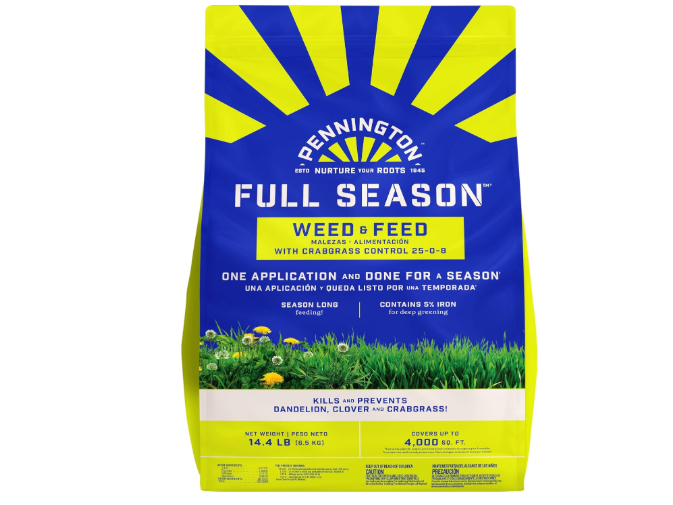
Coverage: 4,000 sq. ft.
NPK Ratio: 25-0-8
Active Ingredients: 2,4-D, Quinclorac
Application: Granular, requires spreader
Pennington Full Season Weed & Feed + Crabgrass Control offers an affordable granular option for Bermuda grass. It kills broadleaf weeds, prevents crabgrass, and feeds the lawn with a high-nitrogen formula, making it a solid budget pick for southern lawns.
Why It’s Great for Bermuda Grass
Bermuda grass loves nitrogen, and Pennington’s 25-0-8 formula delivers, promoting thick, green growth. Its quinclorac targets crabgrass and broadleaf weeds, offering both pre- and post-emergent control. Safe for Bermuda, zoysia, and centipedegrass, it’s a versatile choice for warm-season turf.
How to Apply
Apply to a dry lawn in spring or early fall using a spreader (settings vary by model; check the label). Water thoroughly after application. The 14.4-pound bag covers 4,000 square feet. Avoid use on St. Augustine or new lawns until established.
Pros
- Affordable at ~$25 for 4,000 sq. ft.
- High nitrogen (25%) fuels Bermuda growth.
- Controls crabgrass and broadleaf weeds.
- Easy to find at major retailers like Walmart.
- Safe for multiple warm-season grasses.
Cons
- Smaller coverage compared to BioAdvanced or Spectracide.
- Requires careful application to avoid lawn burn.
- Limited weed spectrum compared to BioAdvanced.
User Feedback
Budget-conscious users love the value, with one saying, “My Bermuda lawn greened up fast, and crabgrass didn’t stand a chance!” Another noted, “It worked well, but I needed two bags for my yard.” Some reported slower weed kill compared to Scotts, but the price kept them satisfied.
Why Choose It?
Pennington is the best budget granular option for Bermuda grass owners who want effective weed control and fertilization without spending a fortune. It’s ideal for smaller lawns or tight budgets.
Comparison Table: Top 5 Weed and Feed Products for Bermuda Grass
| Product | Coverage (sq. ft.) | NPK Ratio | Weed Types Targeted | Application | Best For |
|---|---|---|---|---|---|
| Scotts Turf Builder Weed & Feed3 | 5,000 | 28-0-3 | 50+ broadleaf (dandelions, clover) | Granular | Overall performance |
| Spectracide Weed & Feed | 7,500 | 20-0-0 | Broadleaf (dandelions, clover, poison ivy) | Liquid | Convenience, budget |
| BioAdvanced 5 In 1 | 10,000 | 22-0-4 | 200+ broadleaf, grassy (crabgrass) | Granular | Long-term prevention |
| Scotts Triple ActionI | 4,000 | 16-0-1 | Broadleaf, grassy (crabgrass prevention) | Granular | Crabgrass prevention |
| Pennington Full Season | 4,000 | 25-0-8 | Broadleaf, crabgrass | Granular | Budget granular |
How to Choose the Right Weed and Feed for Your Bermuda Grass
Selecting the best weed and feed depends on your lawn’s condition, weed issues, and preferences. Here are key factors to consider:
1. Weed Types
Identify the weeds in your lawn. Broadleaf weeds like dandelions and clover are common, but grassy weeds like crabgrass require specific herbicides (e.g., quinclorac or pendimethalin). BioAdvanced 5 In 1 excels for both, while Scotts Triple ActionI focuses on crabgrass prevention.
2. Lawn Size
Measure your lawn’s square footage to ensure cost-effective coverage. BioAdvanced (10,000 sq. ft.) and Spectracide (7,500 sq. ft.) suit large lawns, while Pennington and Scotts Triple ActionI (4,000 sq. ft.) work for smaller yards.
3. Application Preference
Granular products (Scotts, BioAdvanced, Pennington) require a spreader for even distribution, offering precise control. Liquid options like Spectracide are easier for beginners but risk overspray. Choose based on your equipment and comfort level.
4. Nutrient Needs
Bermuda grass craves nitrogen for growth. Scotts Weed & Feed3 (28%) and Pennington (25%) deliver high doses, while Scotts Triple ActionI (16%) suits maintenance. Potassium (e.g., BioAdvanced’s 4%) boosts stress resistance.
5. Budget
Spectracide ($13) and Pennington ($25) offer great value, while Scotts Triple ActionI ($40) is pricier. Balance cost with coverage and performance for your needs.
6. Timing
Apply weed and feed in spring or early fall when Bermuda grass and weeds are actively growing (60-90°F). Wet lawns enhance herbicide adhesion, but avoid rain for 24 hours post-application.
Tips for Applying Weed and Feed on Bermuda Grass
To maximize results and protect your lawn, follow these tips:
- Mow First: Cut Bermuda grass to its normal height (1-2 inches) 1-2 days before application to expose weeds.
- Water Strategically: Wet the lawn with dew or light watering before applying granular products. For liquids, water 1-2 days prior. Avoid watering for 24 hours after to let herbicides work.
- Use the Right Spreader: For granular products, use a Scotts broadcast or drop spreader with recommended settings to avoid over- or under-application.
- Check Weather: Apply on calm days to prevent granule drift or liquid overspray. Ensure no rain is forecast for 24 hours.
- Follow Label Instructions: Each product has specific guidelines for Bermuda grass. Overapplication can burn the lawn, while underapplication reduces effectiveness.
- Avoid New Lawns: Most products require Bermuda grass to be established (mowed 4 times) before use to prevent damage.
Common Weeds in Bermuda Grass Lawns and How to Tackle Them
Bermuda grass faces several weed threats. Here’s how the top products address them:
- Dandelions: All five products kill dandelions effectively, with Scotts Weed & Feed3 and Spectracide showing the fastest results.
- Clover: BioAdvanced and Scotts Weed & Feed3 excel at eliminating clover, with users noting die-off in 7-10 days.
- Crabgrass: BioAdvanced and Pennington tackle existing crabgrass, while Scotts Triple ActionI prevents it for four months.
- Chickweed and Plantain: All products control these broadleaf weeds, with BioAdvanced’s 200+ weed spectrum offering the broadest coverage.
For stubborn weeds, a second application (after 30 days) or spot treatment with a separate herbicide may be needed.
Environmental and Safety Considerations
Weed and feed products contain synthetic herbicides like 2,4-D, which can harm non-target plants, pets, and humans if mishandled. Follow these precautions:
- Protect Pets and Kids: Keep them off the lawn until the product dries (usually 24 hours).
- Avoid Waterways: Sweep granules off hard surfaces to prevent runoff into streams or lakes.
- Store Safely: Keep products in a cool, dry place away from children and pets.
- Consider Organic Alternatives: If chemical concerns arise, try cornmeal-based products like Espoma Organic Weed Preventer, though they’re less effective on established weeds.
Frequently Asked Questions
1. Can I use weed and feed on new Bermuda grass?
Most weed and feed products, including these five, are not safe for new Bermuda grass until it’s established (mowed 4 times). For new lawns, use a starter fertilizer like Scotts Turf Builder Starter Food.
2. How often should I apply weed and feed?
Apply once in spring and optionally again in early fall, following label instructions. Most products limit applications to twice per year to avoid lawn burn.
3. Will these products kill existing crabgrass?
BioAdvanced 5 In 1 and Pennington kill existing crabgrass, while Scotts Triple ActionI prevents it but doesn’t kill established plants. For existing crabgrass, consider a separate post-emergent herbicide.
4. Is liquid or granular weed and feed better for Bermuda grass?
Granular products offer precise control and longer-lasting effects, while liquids are easier to apply and act faster. Choose based on your equipment and preferences. Spectracide is the top liquid, while Scotts Weed & Feed3 leads granular options.
5. How long until I see results?
Weed die-off typically starts in 3-7 days, with full results in 2-3 weeks. Greening from fertilizer can appear in 3-5 days for liquids and 7-14 days for granular products.
Conclusion: Which Weed and Feed Is Right for Your Bermuda Grass?
Choosing the best weed and feed for Bermuda grass depends on your lawn’s needs and your preferences. Here’s a quick recap:
- Scotts Turf Builder Weed & Feed3: Best overall for its balance of weed control, high nitrogen, and affordability. Ideal for most Bermuda lawns.
- Spectracide Weed & Feed: Best liquid for convenience and budget-conscious homeowners with large lawns.
- BioAdvanced 5 In 1: Best for long-term weed prevention, especially crabgrass, with large coverage.
- Scotts Triple ActionI: Best for crabgrass prevention and smaller lawns needing balanced care.
- Pennington Full Season: Best budget granular for cost-effective weed control and fertilization.
For most Bermuda grass owners, Scotts Turf Builder Weed & Feed3 delivers the best mix of performance, ease, and value. If you prefer a liquid or need long-term prevention, Spectracide or BioAdvanced are excellent choices. Whichever you pick, follow application guidelines to achieve a lush, weed-free lawn that makes your neighbors jealous.
Have questions or experiences with these products? Drop a comment below, and let’s keep the conversation growing!
